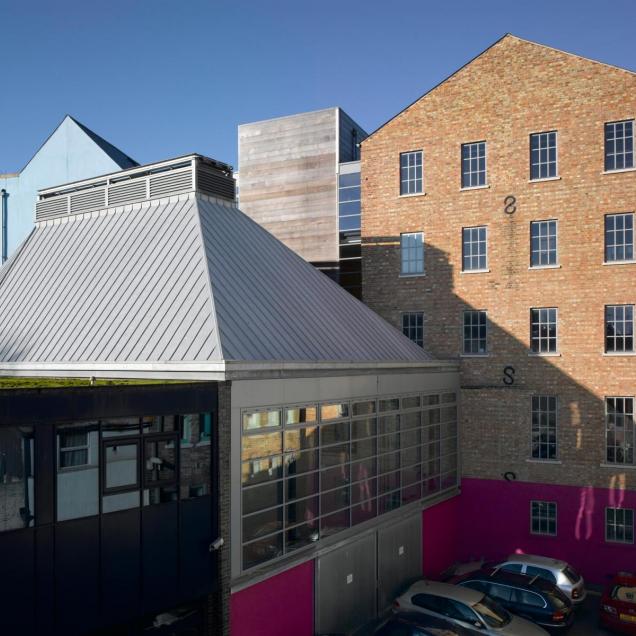

Billionaire businessman Roger de Haan is reversing his Kent home town’s gentle decline into dereliction. Martin Spring found what he’s giving back – and if you turn up at his arts Triennale next summer, you can too …
Three years ago, Roger de Haan sold his family firm. He was 56 years old so his first instinct was to retire, but he decided to become a property developer instead.
An everyday story of small-time business folk, perhaps. Except that the firm was Saga and the sum de Haan and his family reaped from the sale was £1.35bn before tax.
Saga was set up by de Haan’s father in Folkestone in the fifties to provide holidays and financial services to the over-50s. It is now worth £6.8bn, employs 2,500 people and remains based in the Kent seaside town.
Not exactly a developer red in tooth and claw, de Haan takes an enlightened approach, informed by his experience at Saga. “My father and I strongly believed we needed to make Folkestone a successful place to live and run our business in,��? he says. “We thought that the more successful Folkestone was as a town to live in, the more successful our business would be. So when I sold Saga, I decided to focus on regenerating the town.��?
For a man ranked 78th on the Sunday Times Rich List, with a reputation for extraordinary drive, de Haan comes across as modest and unassuming in manner. He granted Building a rare interview at his office in an early Victorian house in a western suburb of Folkestone, a few hundred yards from Saga’s headquarters. Although small and unprepossessing from the street, the building’s interior reveals another de Haan passion – contemporary architecture.
Picking one’s way through the plastered front rooms, the visitor notices there is no back wall. Instead, a frameless glass screen opens onto a wide shingle beach a few steps away and the English Channel beyond that.
The house conversion was designed by local architect Cheney Thorpe & Morrison. For more ambitious schemes, de Haan has brought in such big-league architects as Foster + Partners, Pringle Richards Sharratt and Alison Brooks Architects. He also regularly works with cost consultant Davis Langdon and town planner Montagu Evans.
To regenerate Folkestone, de Haan homed in on the old town centre next to the harbour, which he says was “extremely rundown and fast turning into a slum��? in 2004. He is also working to revive the harbour itself, from where the ferry service to France ran, before it was killed off by the Channel Tunnel in 1994.
De Haan takes a philanthropic approach to urban regeneration – more like a charitable organisation such as the National Trust than a private property developer. “Our first idea was to create an artists’ quarter and later we developed this into the Creative Quarter,��? he says. “This entails buying rundown properties in the area, renovating them and leasing them at affordable rents to people in the creative industries.��?
The big risk here is what de Haan calls “the Hoxton effect��?, referring to the district to the north of the City of London, which was colonised by artists, designers and film-makers. “Often, artists are used to help regenerate an area and once it’s regenerated they’re forced out because rents are too high.��?
De Haan’s solution is to retain the freehold of the properties and rent them directly to end users on 125-year leases and peppercorn rents. This is where his personal fortune plays its part. He is bankrolling two charitable trusts that plough the revenue generated by refurbished properties back into the regeneration pot.
The first is the Roger de Haan Charitable Trust, which buys properties, renovates them and retains the freehold. The second is the Creative Foundation, which has representatives from Canterbury Christ Church University and the South East England Development Agency as fellow trustees. The Creative Foundation manages the properties and stages arts festivals and other cultural events in the area. Its latest initiative is to launch the Folkestone Triennial, which bills itself as “a major three yearly exhibition in the public realm��?.
The Creative Foundation grew out of Folkestone’s long-standing Metropole Arts Trust, which first called on de Haan and Saga’s support in the late nineties, when it was losing its grants and financial support. “So it wasn’t a great jump for me to continue and concentrate on supporting the town and its charities and institutions,��? he says. It was also the connection with Metropole that led to the area’s revival being aimed at the creative industries.
Now, three years into the regeneration project, about £42m has been sunk into acquiring 65 mostly small-scale, properties in the Creative Quarter and refurbishing them. Many have been converted and let to a bubbling new community of fashion shops, hairdressing salons, small restaurants and a florist-cum-coffee-shop. A £4m performing arts centre designed by Alison Brooks has just started construction and will combine a flexible auditorium and business start-up units for creative companies. The next stage will be to unravel a tortuous one-way road system by working with the county and district councils.
So far, so good. “But these efforts would not be fully successful,��? warns de Haan, “unless we looked at some of the broader issues. One of these is education.
“When we started this project, Folkestone had one of the worst performing secondary schools. This school served most of the people from the east end of town – the slum area around the harbour – so we built a city academy, which I sponsored.��? The new academy, built to a highly original design by Foster + Partners, opened last week.
Link: Building 21st September 2007
© Building 2007